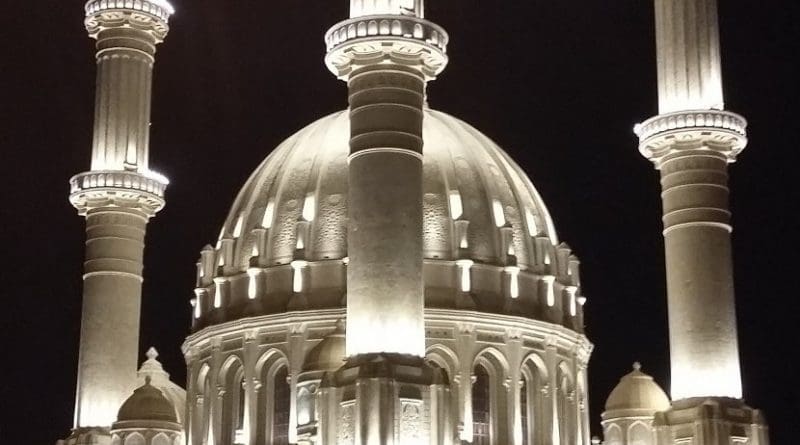The Enshrined Religious Architecture Of Nakhchivan – Azerbaijan
By Peter Tase
During the leadership of the President of Azerbaijan, Mr. Ilham Aliyev and Mr. Vasif Talibov, Chairman of the Supreme Assembly in Nakhchivan Autonomous Republic, the preservation of religious monuments has acquired a special priority and a constant attention.
The westernmost region of Azerbaijan, Autonomous Republic of Nakhchivan has a wealth of unique religious monuments that have resisted, prevailed over the brutal destruction taking place under the Soviet Union regime. Some of these religious monuments represent a global significance and have been restored only recently; they are located in the regions of Sharur and Babek.
The international community knows very little about the Heydar Mosque of Ashaghi Aralig Village, built in a territory of 419 square meters and inaugurated in 1996. The structure of the mosque is in a modern style that embodies Eastern architectural elements and has two floors. The yard of this mosque is surrounded with iron patterns decorated with botanical and geometrical designs as well as religious symbols. The ground floor is well equipped and destined for men to pray and the first floor is subsequently for women.
In the Heydar Mosque of Ashaghi Aralig Village, there are separate entrances assigned to men and women that lead to the main praying halls. Males use the southern door which is the main entrance to the Mosque, while women use the door in the western side of this red brick unique religious monument.
It must be emphasized that the mosque is a square shaped building with two thin minarets that generate a special architectural feature, sensation in the Village of Ashaghi Aralig, Sharur Region, and the thickness of its main walls reaches over 50 cm. The words “Heydar Mosque” are written with green glazed tiles in the dome and an inscription of the Koran is placed over the main entrance door. The walls of Heydar Mosque are painted with a red brick color from outside therefore scintillating a special appearance, while the trimming sides of doors and windows are painted with a bright white color.
The Village of Cheshmabasar, Babek Region is home of Heydar Mosque – a XX Century religious monument that adds special components to the collection of Nakhchivan’s religious architecture. This square shaped structure has 110 square meters of prayer halls, an opened site joining the hall from the western and northern sides, a combined room and an astonishing minaret.
The Mosque of Cheshmabasar has four stone columns in the center of its prayer hall were they grow narrower from the bottom towards their heights. The diameter of its round shaped dome is 9.5 meters. The porches built inside the mosque are designed especially for women to pray. Entering the inside porches will unravel to the visitors a rare opportunity to appreciate religious architecture that is astounding in Nakhchivan – Azerbaijan.
The big entrance doors of the Heydar Mosque have been constructed in the Northern and Western directions. In the southern wall of the praying hall there is an altar recess that looks like a mild extension; furthermore the main praying hall is enlightened thanks to large beautiful windows.
Another principal religious monument is the Heydarkhanli Mosque, located in the Village of Jahri, Babek Region. This architectural monument is built with square shaped bricks; its main entrance is adorned with burned beige rocks. This Mosque has been damaged during the Soviet Union period; it served as a warehouse where grain, wheat and corn commodities were stored for years. This is the reason why its restoration process has encountered difficulties that are inherited up to the present. The entrance from the southern side, in the Heydarkhanli Mosque has been divided by columns that furnish a special feature in the internal formation of the building. It must be noted that to the Northern and Eastern walls of the mosque there is a wide shaped pavement built by bricks; this is indeed a section assigned to women.
The altar of the Mosque consists of two extended and vast alcoves as well as spanned ornaments that join each other. The roof of this mosque is covered by wooden poles. The old structure, while having special architecture values is under construction and will introduce tourists with special architectural features that have been adopted originally in Azerbaijan and in other parts of Europe, in the later stages.
This XV century mosque has played an important role towards preserving the religious identity in Nakhchivan and provides international scholars with valuable information about the advent of Islamic Faith in the Caucasus and Europe. The Heydarkhanli Mosque was fully repaired in the 19th century and until today represents architectural features that ethnologists would highly appreciate; at a time when Nakhchivan has been selected as the 2018 Capital of Islamic Culture in the Asian Region, by the Islamic Educational, Scientific and Cultural Organization. Visitors, tourists are always welcomed in Nakhchivan – Azerbaijan, a country with a diversity of ecosystems, awesome culinary tradition, outstanding religious architecture and constantly enriched by highly talented people. With its innovative urban design and religious architecture, Nakhchivan has a unique metropolitan sensation and charm.

